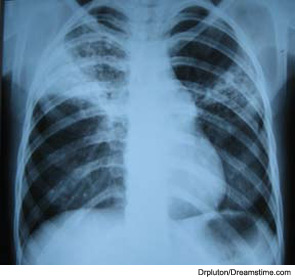Sources:
- lupus erythematosus. (2011). In Encyclopædia Britannica. Available at: http://www.britan nica.com/EBchecked/topic/351725/lupus-erythematosus. Accessed July 20, 2011.
- Potter B. The History of the Disease Called Lupus. J Hist Med Allied Sci. 1993;48:80-90.
X-RAY:
The discovery of X-rays is credited to Wilhelm Conrad Röntgen in 1895. One of his first medical X-ray photographs is of his wife’s left hand. He named the short-length radiation “X” for “unknown radiation.”
Source:
- Novelline R. Squire’s Fundamentals of Radiology. Harvard University Press. 5th edition. 1997. Available at: http://en.wikipedia.org/wiki/X-ray. Accessed July 20, 2011.
SYNOVITIS:
Merriam-Webster’s simply defines synovitis as the inflammation of synovial membranes surrounding a joint. The word “synovia” comes from the Greek syn meaning “with” and the Latin ovum for “egg” because the viscous fluid resembles that of an egg white. The term was most likely coined by Paracelsus, a Swiss physician, in the 16th century.
Sources:
- synovitis. Merriam-Webster Dictionary and Thesaurus website. Available at: http://www.merriam-webster.com/medical/synovitis. Accessed July 20, 2011.
- synovia. Dictionary.com. Dictionary.com Unabridged. Random House, Inc. Available at: http://dictionary.reference.com/browse/synovia. Accessed July 21, 2011.
- Edwards JCW (2003). Chapter 17. In Klippel, John H.; Hochberg, Marc C. Rheumatology. St. Louis: Mosby. pp. 159–68. Available at: http://en.wikipedia.org/wiki/Synovial_membrane#cite_note-2. Accessed July 21, 2011.

LYME DISEASE:
Named for the town in Connecticut where it was first diagnosed, Lyme disease is a bacteria transmitted through the deer tick and causes a number of symptoms. The most tell-tale sign of Lyme disease is a “bull’s-eye rash,” but since the symptoms are not predictable, many cases go undiagnosed, and often patients are misdiagnosed when they show a rash and flu-like symptoms. If Lyme disease goes untreated, a patient can develop Lyme arthritis.
Source:
- Understanding Lyme Disease – The Basics. WebMD. Available at: http://www.webmd.com/a-to-z-guides/understanding-lyme-disease-basics. Accessed July 21, 2011.
TUBERCULOSIS (TB):
The name of a family of infectious bacteria that attack different areas of the body depending on the strain. Traditional TB attacks the lungs, but tuberculosis arthritis, or Pott Disease (tuberculosis spondylitis), affects the spinal column. Named for a British surgeon, Sir Percivall Pott, who described the condition in 1779, Pott Disease usually causes deterioration of membranes surrounding the vertebrae, resulting in a hunchback.
Source:
- Pott disease. (2011). In Encyclopædia Britannica. Available at: http://www.britannica.com/EBchecked/topic/472936/Pott-disease. Accessed July 21, 2011.
BONE:
Merriam-Webster’s says that bone is “the hard largely calcareous connective tissue of which the adult skeleton of most vertebrates is chiefly composed.” The word has German origins and probably came from a German or Dutch cognate meaning “shank of the leg.”
